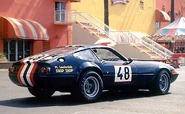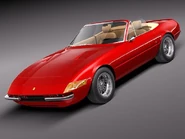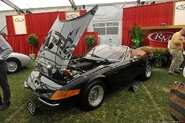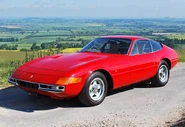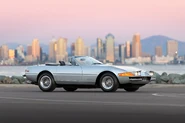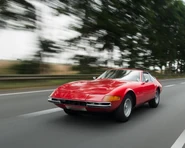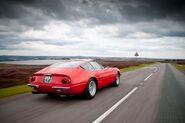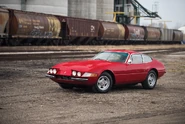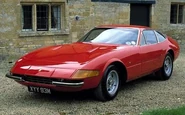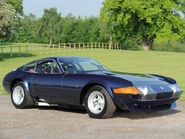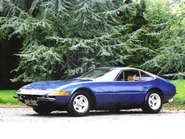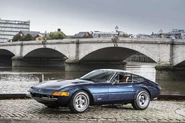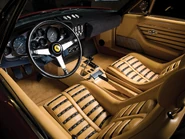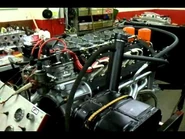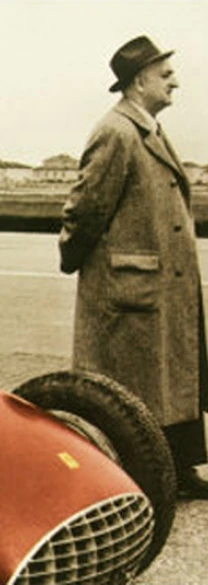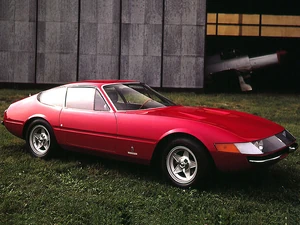
| |
| Ferrari 365 GTB/4 | |
|---|---|
| Ferrari | |
| aka | Daytona |
| Production | 1968-1976 1,284 Coupes (incl. 158 RHD) 122 Spiders |
| Class | Sports Car |
| Body Style | 2-door coupe |
| Length | 4,425 mm (174.2 in) |
| Width | 1,760 mm (69.3 in) |
| Height | 1,245 mm (49, 0 in) |
| Wheelbase | 2,400 mm (94.5 in) |
| Weight | 1,200 kg (2,646 lb) (GTB/4, dry) |
| Transmission | 5-speed manual |
| Engine | 4.4 litre (4390 cc) Ferrari "Tipo 251" Colombo V12 |
| Power | 352 hp |
| Similar | Lamborghini Miura Maserati Ghibli De Tomaso Mangusta |
| Designer | Leonardo Fioravanti under Pininfarina |
- See also Ferrari 365 for the round-bodied 365 California, GT 2+2, GTC and GTS
The Ferrari Daytona (correctly named the 365 GTB/4) is a Gran Turismo automobile produced from 1968 to 1973. It was first introduced to the public at the Paris Auto Salon in 1968 and replaced the 275GTB/4 but, although it was also a Pininfarina design (by Leonardo Fioravanti), the Daytona was radically different. Its sharp-edged styling resembled a Lamborghini more than a traditional Pininfarina Ferrari. The Daytona name commemorates Ferrari's triple success in the February 1967 24 Hours of Daytona with the 330P4. While it was initially used as a pre-production internal denomination, Ferrari still insists that this was never the model's official name and as such should not be used when referring to the car in any true manner.
Unlike Lamborghini's new Miura, the Daytona was a traditional front-engined, rear-drive car. Customers were disappointed that Ferrari stuck with this layout unlike with the race cars, and the Daytona was replaced by the mid-engined 365 GTB Berlinetta Boxer in 1973. Today, the car represents the last of the great front engine Ferrari GTs before this layout was revived in the 1990s.
Engine and transmission[]
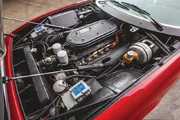
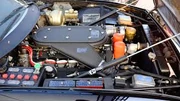

The engine, known as a Tipo 251 and developed from the earlier Lampredi V12 used in the 275 GTB/4, was a 4.4 L (4390 cc) DOHC V12 with a 60° bank angle, 365 cc per cylinder, 81 mm bore and 71 mm stroke, featuring six Weber twin carburettors (40mm Solex twin carburettors were used alternatively). At a compression ratio of 9.3:1, it produced 352 bhp DIN (259 kW) and could reach 280 km/h (174 mph). 0-60 mph acceleration was just 5.4 seconds. For the American version, slight modifications were made - the compression ratio was reduced to 8.8:1 and the exhaust system was equipped with a large central silencer, necessitating visible alterations to the primary pipes.
The 5-speed manual transmission (Transaxle concept) was mounted in the rear for optimal weight distribution, and a 4-wheel independent suspension featured wishbones and coil springs.
Early Daytonas featured fixed headlights behind a acrylic glass cover. This particular setup was completely abandoned in favor of pop-up twin headlights when lobbying efforts by the CAS led to a variety of new safety regulations for U.S. road traffic in 1970, one of which concerning minimum ride height.
Performance[]
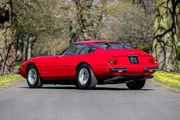
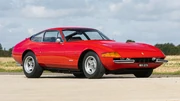

| 0 - 40 kph | 2.0 s |
| 0 - 60 kph | 3.1 s |
| 0 - 80 kph | 4.1 s |
| 0 - 100 kph | 6.1 s |
| 0 - 120 kph | 7.8 s |
| 0 - 140 kph | 10.2 s |
| 0 - 160 kph | 12.9 s |
| 0 - 180 kph | 16.3 s |
| 0 - 200 kph | 21.6 s |
| 0 - 220 kph | 28.1 s |
| 1000 m | 24.7 s @ 214.4 kph |
| Est. 100 - 140 kph | 4.0 s |
| Est. 100 - 200 kph | 15.1 s |
| 0 - 30 mph | 2.4 s |
| 0 - 40 mph | 3.3 s |
| 0 - 50 mph | 4.3 s |
| 0 - 60 mph | 5.2 s |
| 0 - 70 mph | 7.0 s |
| 0 - 80 mph | 8.3 s |
| 0 - 100 mph | 12.0 s |
| 0 - 120 mph | 18.3 s |
| Est. 1/8 mile | 10.2 s @ 84.5 mph |
| 1/4 mile | 13.4 s @ 108.0 mph |
| Top speed | 280 kph (174 mph) |
| Est. max acceleration | 0.48 g (5 |
Model history[]
Achievements and notoriety[]
In 1971, the Daytona gained fame, or infamy depending on your point of view, when a Sunoco Blue example was driven by racing legend Dan Gurney and Car and Driver editor at large Brock Yates the entire 2876 miles from New York to L.A. in 35 hours 54 minutes (at an average speed of 80 mph) to win the inaugural Cannonball Baker Sea-To-Shining-Sea Memorial Trophy Dash. The two claim to have driven the car to 172 mph on the backroads of Arizona. Befitting the car's heritage, both reported afterward the car's stability to be rock solid the entire trip, even at that elevated speed.
This 1971 Ferrari 365 GTB/4, serial number 14271, belonged to exotic car dealer Kirk F. White, who loaned it to Yates and Gurney for the race. White afterwards offered to sell the car to Gurney at a bargain price of $15,000, but Gurney regrettably could not afford it at the time. It is currently a prized vintage piece in the collection of Bruce McCaw, restored to its historic racing livery: midnight blue with yellow pinstriping.
In 2004, the Daytona was voted top sports car of the 1970s by Sports Car International magazine. Similarly, Motor Trend Classic named the 365 GTB/4 and GTS/4 as number two in their list of the ten "Greatest Ferraris of all time".
At least two Ferrari Daytonas appeared in Herbie Goes to Monte Carlo. One was red with a diagonal yellow stripe on the hood and a number 44 on a yellow circle background. The other was silver with a number 22 on doors and hood. However, in some scenes, this latter car appeared in dark green as well.
Replicas and legal issues[]
In the 1980s the car gained new notoriety as Detective Sonny Crockett's car in the first two seasons of NBC's hit television series Miami Vice Ironically, the actual car used for filming the show was a modified 1980 Chevrolet Corvette C3. Ferrari, reportedly upset that a replica was getting so much attention, later supplied two new Testarossas for use in the show. However, the stock twelve cylinder Ferrari engines were removed and replaced with eight cylinder Chevrolet engines to decrease maintenance costs.
In the 1980's and early 1990's, several companies began offering replica Daytonas, typically based on a Chevrolet Corvette C3 chassis and drivetrain. They were available in either fully assembled form or as "do it yourself" (DiY) conversion kits. Due to the influence of Miami Vice, the cost of genuine, well-maintained Daytonas increased markedly, making the far less expensive conversions an attractive alternative. Turnkey replicas typically cost about $70,000 while used ones in good condition will sell for up to $40,000, compared to well over $150,000 for genuine Berlinettas and up to $500,000 and more for genuine Spyders.
In response, Ferrari threatened legal action against some manufacturers for trademark rights violations and plagiarism. Ferrari actively monitors the manufacture and sale of these replicas closely; the few remaining makers now widely refrain from marketing their products as replica Ferrari models and downplay the resemblance to the genuine cars, which includes rarely using freely available identifier badges. Recently, ebaymotors.com has made efforts to delete auctions in which Ferrari Daytona replicas were advertised as being just that.
Model variations[]
365 GTS/4[]
165 convertible Spider models were produced among the 1,426 Daytonas in total. Five of these were lightweight competition models with aluminium bodywork and 450 bhp DIN (331 kW).
Historically, and especially since the mid-80s and early 90s, there has mostly been a considerable market price difference between a real Berlinetta and a real Spyder. In hope for higher value and prospective sale revenue or even due to the fact that not too many factory spyders were ever built, some Berlinettas were turned into convertibles. They are usually distinguishable from a factory-made GTS by a more slanted windshield.
365 GTC/4[]
Although not generally recognized as a true "Daytona", the 1971 365 GTC/4 used the same chassis. Its coupe bodywork by Pininfarina enclosed four seats, making it a successor to the 2+2 330 GTC and 365 GTC. 500 GTC/4s were produced in two years.
The GTC/4 rode on the same wheelbase and suspension as the Daytona, though the engine was down in power a bit to 340 bhp DIN (250 kW), as well as it having a regular gearbox instead of the rear mounted (transaxle) gearbox in the Daytona. This car was seen in Herbie Goes to Monte Carlo. It was painted a very dark shade of green with a black numeral 70 against an off-white square background.
365 GT4 2+2[]
In 1972, just a year after the debut of the GTC/4, a new 2+2 debuted in Paris. The 365 GT4 2+2 featured all-new bodywork with just a resemblance to the Daytona. Its angular look would go on to be used by many 1980s Ferraris, especially the Mondial. The wheelbase was 200 mm longer at 2700 mm, but most of the mechanicals, including the engine, were carried over. The GT4 was replaced in 1976 by the new 400 Automatic.
Naming[]
The car was orginally named the Ferrari Daytona because it was set to compete in the 24 Hours Of Daytona Event. After the car was retired from racing, it was re-named and re-configured.
Photos[]
See Also[]
External Links[]
- Happy Birthday, Daytona
- www.ferrari-daytona.co.uk - comprehensive guide to the Ferrari 365 GTB/GTS and its history
